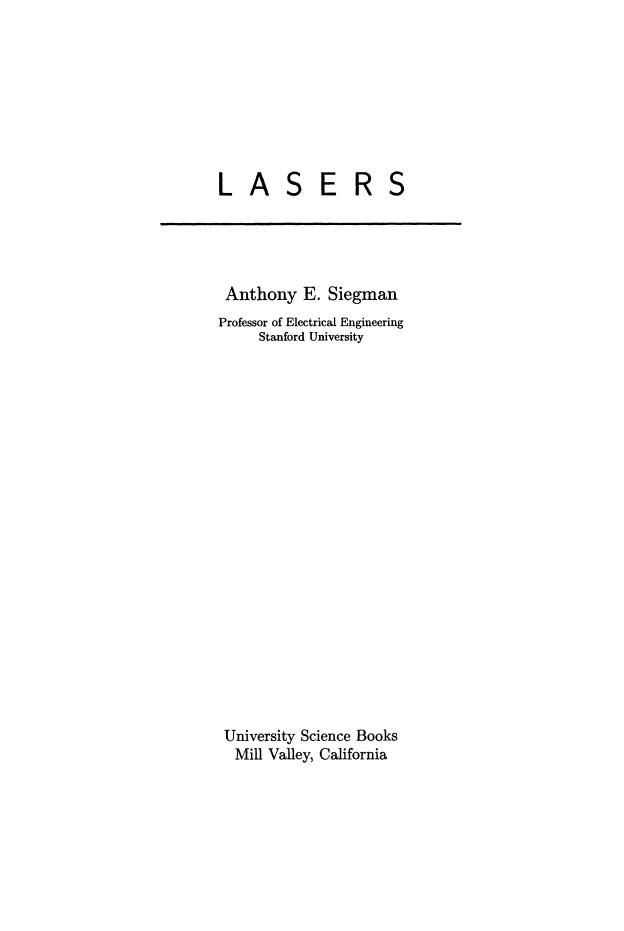
LASERS Anthony E. Siegman Professor of Electrical Engineering Stanford University University Science Books Mill Valley, California
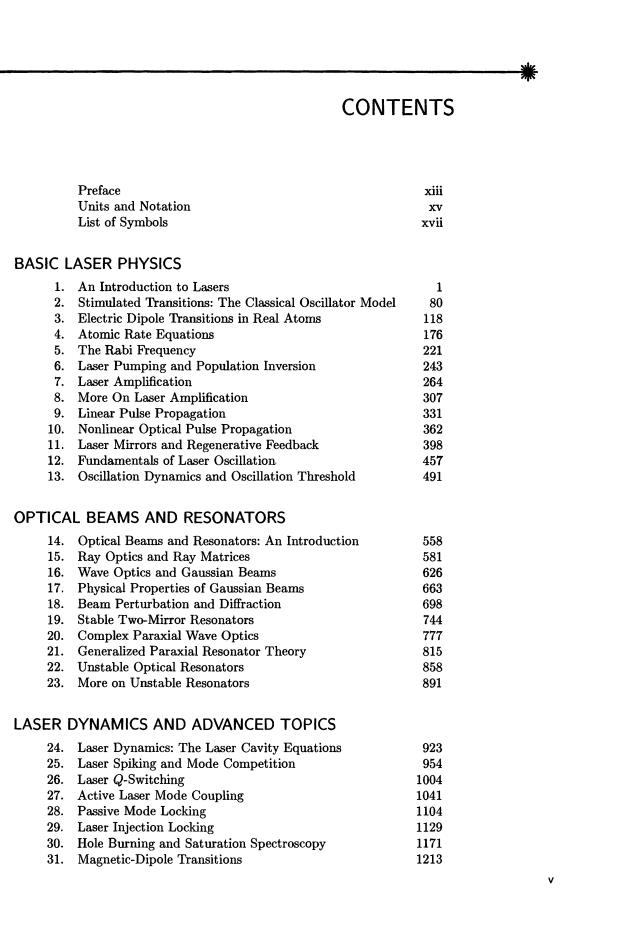
CONTENTS Preface xili Units and Notation XV List of Symbols xvii BASIC LASER PHYSICS 1.An Introduction to Lasers 1 2. Stimulated Transitions:The Classical Oscillator Model 80 3. Electric Dipole Transitions in Real Atoms 118 4. Atomic Rate Equations 176 5. The Rabi Frequency 221 6. Laser Pumping and Population Inversion 243 7.Laser Amplification 264 8. More On Laser Amplification 307 9. Linear Pulse Propagation 331 10. Nonlinear Optical Pulse Propagation 362 11. Laser Mirrors and Regenerative Feedback 398 12. Fundamentals of Laser Oscillation 457 13. Oscillation Dynamics and Oscillation Threshold 491 OPTICAL BEAMS AND RESONATORS 14.Optical Beams and Resonators:An Introduction 558 15.Ray Optics and Ray Matrices 581 16. Wave Optics and Gaussian Beams 626 17.Physical Properties of Gaussian Beams 663 18. Beam Perturbation and Diffraction 698 19. Stable Two-Mirror Resonators 744 20. Complex Paraxial Wave Optics 777 21. Generalized Paraxial Resonator Theory 815 22. Unstable Optical Resonators 858 23.More on Unstable Resonators 891 LASER DYNAMICS AND ADVANCED TOPICS 24.Laser Dynamics:The Laser Cavity Equations 923 25.Laser Spiking and Mode Competition 954 26.Laser Q-Switching 1004 27.Active Laser Mode Coupling 1041 28. Passive Mode Locking 1104 29. Laser Injection Locking 1129 30.Hole Burning and Saturation Spectroscopy 1171 31.Magnetic-Dipole Transitions 1213
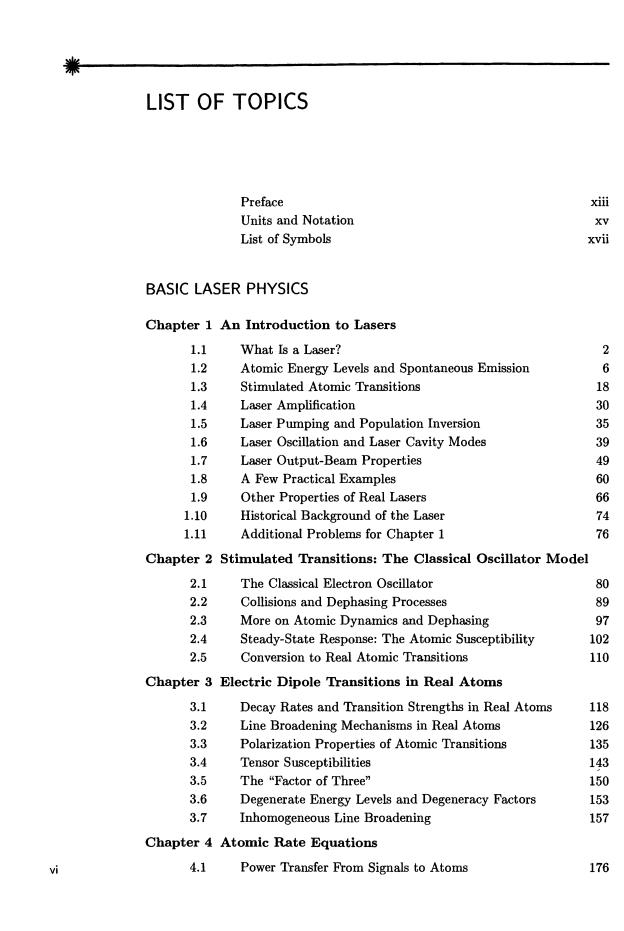
LIST OF TOPICS Preface xiii Units and Notation xV List of Symbols xvii BASIC LASER PHYSICS Chapter 1 An Introduction to Lasers 1.1 What Is a Laser? 1.2 Atomic Energy Levels and Spontaneous Emission 6 1.3 Stimulated Atomic Transitions 18 1.4 Laser Amplification 1.5 Laser Pumping and Population Inversion 1.6 Laser Oscillation and Laser Cavity Modes 059 1.7 Laser Output-Beam Properties 1.8 A Few Practical Examples 6 1.9 Other Properties of Real Lasers 1.10 Historical Background of the Laser 74 1.11 Additional Problems for Chapter 1 76 Chapter 2 Stimulated Transitions:The Classical Oscillator Model 2.1 The Classical Electron Oscillator 80 2.2 Collisions and Dephasing Processes 89 2.3 More on Atomic Dynamics and Dephasing 97 2.4 Steady-State Response:The Atomic Susceptibility 102 2.5 Conversion to Real Atomic Transitions 110 Chapter 3 Electric Dipole Transitions in Real Atoms 3.1 Decay Rates and Transition Strengths in Real Atoms 118 3.2 Line Broadening Mechanisms in Real Atoms 126 3.3 Polarization Properties of Atomic Transitions 135 3.4 Tensor Susceptibilities 143 3.5 The“Factor of Three" 150 3.6 Degenerate Energy Levels and Degeneracy Factors 153 3.7 Inhomogeneous Line Broadening 157 Chapter 4 Atomic Rate Equations vi 4.1 Power Transfer From Signals to Atoms 176

LIST OF TOPICS vii 4.2 Stimulated Transition Probability 181 4.3 Blackbody Radiation and Radiative Relaxation 187 4.4 Nonradiative Relaxation 195 4.5 Two-Level Rate Equations and Saturation 204 4.6 Multilevel Rate Equations 211 Chapter 5 The Rabi Frequency 5.1 Validity of the Rate Equation Model 221 5.2 Strong Signal Behavior:The Rabi Frequency 229 Chapter 6 Laser Pumping and Population Inversion 6.1 Steady-State Laser Pumping and Population Inversion 243 6.2 Laser Gain Saturation 252 6.3 Transient Laser Pumping 257 Chapter 7 Laser Amplification 7.1 Practical Aspects of Laser Amplifiers 264 7.2 Wave Propagation in an Atomic Medium 266 7.3 The Paraxial Wave Equation 276 7.4 Single-Pass Laser Amplification 279 7.5 Stimulated Transition Cross Sections 286 7.6 Saturation Intensities in Laser Materials 292 7.7 Homogeneous Saturation in Laser Amplifiers 297 Chapter 8 More On Laser Amplification 8.1 Transient Response of Laser Amplifiers 307 8.2 Spatial Hole Burning,and Standing-Wave Grating Effects 316 8.3 More on Laser Amplifier Saturation 323 Chapter 9 Linear Pulse Propagation 9.1 Phase and Group Velocities 331 9.2 The Parabolic Equation 339 9.3 Group Velocity Dispersion and Pulse Compression 343 94 Phase and Group Velocities in Resonant Atomic Media 351 9.5 Pulse Broadening and Gain Dispersion 356 Chapter 10 Nonlinear Optical Pulse Propagation 10.1 Pulse Amplification With Homogeneous Gain Saturation 362 10.2 Pulse Propagation in Nonlinear Dispersive Systems 375 10.3 The Nonlinear Schrodinger Equation 387 10.4 Nonlinear Pulse Broadening in Optical Fibers 388 10.5 Solitons in Optical Fibers 392 Chapter 11 Laser Mirrors and Regenerative Feedback 11.1 Laser Mirrors and Beam Splitters 398 11.2 Interferometers and Resonant Optical Cavities 408 11.3 Resonance Properties of Passive Optical Cavities 413

vii LIST OF TOPICS 11.4 "Delta Notation"for Cavity Gains and Losses 428 11.5 Optical-Cavity Mode Frequencies 432 11.6 Regenerative Laser Amplification 440 11.7 Approaching Threshold:The Highly Regenerative Limit 447 Chapter 12 Fundamentals of Laser Oscillation 12.1 Oscillation Threshold Conditions 457 12.2 Oscillation Frequency and Frequency Pulling 462 12.3 Laser Output Power 473 12.4 The Large Output Coupling Case 485 Chapter 13 Oscillation Dynamics and Oscillation Threshold 13.1 Laser Oscillation Buildup 491 13.2 Derivation of the Cavity Rate Equation 497 13.3 Coupled Cavity and Atomic Rate Equations 505 13.4 The Laser Threshold Region 510 13.5 Multiple-Mirror Cavities and Etalon Effects 524 13.6 Unidirectional Ring-Laser Oscillators 532 13.7 Bistable Optical Systems 538 13.8 Amplified Spontaneous Emission and Mirrorless Lasers 547 OPTICAL BEAMS AND RESONATORS Chapter 14 Optical Beams and Resonators:An Introduction 14.1 Transverse Modes in Optical Resonators 559 14.2 The Mathematics of Optical Resonator Modes 565 14.3 Build-Up and Oscillation of Optical Resonator Modes 569 Chapter 15 Ray Optics and Ray Matrices 15.1 Paraxial Optical Rays and Ray Matrices 581 15.2 Ray Propagation Through Cascaded Elements 593 15.3 Rays in Periodic Focusing Systems 599 15.4 Ray Optics With Misaligned Elements 607 15.5 Ray Matrices in Curved Ducts 614 15.6 Nonorthogonal Ray Matrices 616 Chapter 16 Wave Optics and Gaussian Beams 16.1 The Paraxial Wave Equation 626 16.2 Huygens'Integral 16.3 Gaussian Spherical Waves 16.4 Higher-Order Gaussian Modes 新嫩 16.5 Complex-Argument Gaussian Modes 16.6 Gaussian Beam Propagation in Ducts 652 16.7 Numerical Beam Propagation Methods 656

LIST OF TOPICS x Chapter 17 Physical Properties of Gaussian Beams 17.1 Gaussian Beam Propagation 663 17.2 Gaussian Beam Focusing 675 17.3 Lens Laws and Gaussian Mode Matching 680 17.4 Axial Phase Shift:The Guoy Effect 682 17.5 Higher-Order Gaussian Modes 685 17.6 Multimode Optical Beams 695 Chapter 18 Beam Perturbation and Diffraction 18.1 Grating Diffraction and Scattering Effects 698 18.2 Aberrated Laser Beams 706 18.3 Aperture Diffraction:Rectangular Apertures 712 18.4 Aperture Diffraction:Circular Apertures 727 Chapter 19 Stable Two-Mirror Resonators 19.1 Stable Gaussian Resonator Modes 744 19.2 Important Stable Resonator Types 750 19.3 Gaussian Transverse Mode Frequencies 761 19.4 Misalignment Effects in Stable Resonators 767 19.5 Gaussian Resonator Mode Losses 769 Chapter 20 Complex Paraxial Wave Optics 20.1 Huygens'Integral and ABCD Matrices 777 20.2 Gaussian Beams and ABCD Matrices 782 20.3 Gaussian Apertures and Complex ABCD Matrices 786 20.4 Complex Paraxial Optics 792 20.5 Complex Hermite-Gaussian Modes 798 20.6 Coordinate Scaling with Huygens'Integrals 805 20.7 Synthesis and Factorization of ABCD Matrices 811 Chapter 21 Generalized Paraxial Resonator Theory 21.1 Complex Paraxial Resonator Analysis 815 21.2 Real and Geometrically Stable Resonators 820 21.3 Real and Geometrically Unstable Resonators 822 21.4 Complex Stable and Unstable Resonators 828 21.5 Other General Properties of Paraxial Resonators 835 21.6 Multi-Element Stable Resonator Designs 841 21.7 Orthogonality Properties of Optical Resonator Modes 847 Chapter 22 Unstable Optical Resonators 22.1 Elementary Properties 858 22.2 Canonical Analysis for Unstable Resonators 867 22.3 Hard-Edged Unstable Resonators 874 22.4 Unstable Resonators:Experimental Results 884 Chapter 23 More on Unstable Resonators 23.1 Advanced Analyses of Unstable Resonators 891
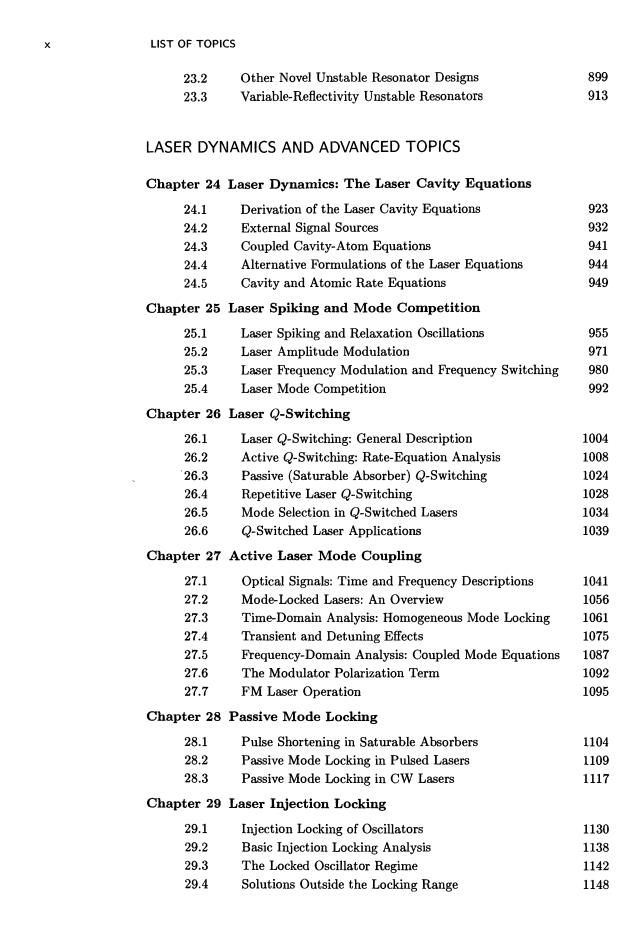
LIST OF TOPICS 23.2 Other Novel Unstable Resonator Designs 899 23.3 Variable-Reflectivity Unstable Resonators 913 LASER DYNAMICS AND ADVANCED TOPICS Chapter 24 Laser Dynamics:The Laser Cavity Equations 24.1 Derivation of the Laser Cavity Equations 923 24.2 External Signal Sources 932 24.3 Coupled Cavity-Atom Equations 941 24.4 Alternative Formulations of the Laser Equations 944 24.5 Cavity and Atomic Rate Equations 949 Chapter 25 Laser Spiking and Mode Competition 25.1 Laser Spiking and Relaxation Oscillations 955 25.2 Laser Amplitude Modulation 971 25.3 Laser Frequency Modulation and Frequency Switching 980 25.4 Laser Mode Competition 992 Chapter 26 Laser Q-Switching 26.1 Laser Q-Switching:General Description 1004 26.2 Active Q-Switching:Rate-Equation Analysis 1008 26.3 Passive (Saturable Absorber)Q-Switching 1024 26.4 Repetitive Laser Q-Switching 1028 26.5 Mode Selection in Q-Switched Lasers 1034 26.6 Q-Switched Laser Applications 1039 Chapter 27 Active Laser Mode Coupling 27.1 Optical Signals:Time and Frequency Descriptions 1041 27.2 Mode-Locked Lasers:An Overview 1056 27.3 Time-Domain Analysis:Homogeneous Mode Locking 1061 274 Transient and Detuning Effects 1075 27.5 Frequency-Domain Analysis:Coupled Mode Equations 1087 27.6 The Modulator Polarization Term 1092 27.7 FM Laser Operation 1095 Chapter 28 Passive Mode Locking 28.1 Pulse Shortening in Saturable Absorbers 1104 28.2 Passive Mode Locking in Pulsed Lasers 1109 28.3 Passive Mode Locking in CW Lasers 1117 Chapter 29 Laser Injection Locking 29.1 Injection Locking of Oscillators 1130 29.2 Basic Injection Locking Analysis 1138 29.3 The Locked Oscillator Regime 1142 29.4 Solutions Outside the Locking Range 1148
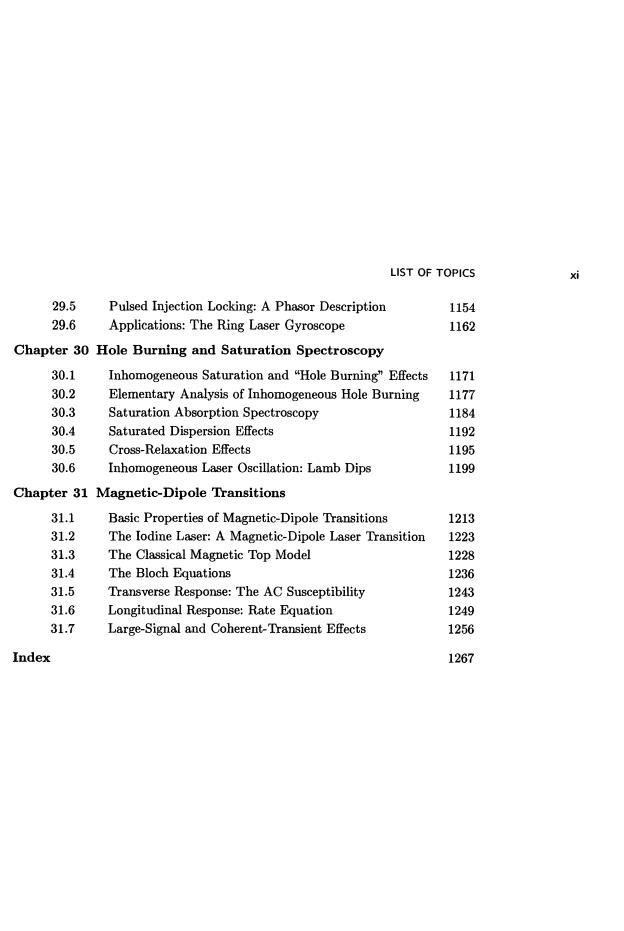
LIST OF TOPICS xi 29.5 Pulsed Injection Locking:A Phasor Description 1154 29.6 Applications:The Ring Laser Gyroscope 1162 Chapter 30 Hole Burning and Saturation Spectroscopy 30.1 Inhomogeneous Saturation and "Hole Burning"Effects 1171 30.2 Elementary Analysis of Inhomogeneous Hole Burning 1177 30.3 Saturation Absorption Spectroscopy 1184 30.4 Saturated Dispersion Effects 1192 30.5 Cross-Relaxation Effects 1195 30.6 Inhomogeneous Laser Oscillation:Lamb Dips 1199 Chapter 31 Magnetic-Dipole Transitions 31.1 Basic Properties of Magnetic-Dipole Transitions 1213 31.2 The Iodine Laser:A Magnetic-Dipole Laser Transition 1223 31.3 The Classical Magnetic Top Model 1228 31.4 The Bloch Equations 1236 31.5 Transverse Response:The AC Susceptibility 1243 31.6 Longitudinal Response:Rate Equation 1249 31.7 Large-Signal and Coherent-Transient Effects 1256 Index 1267
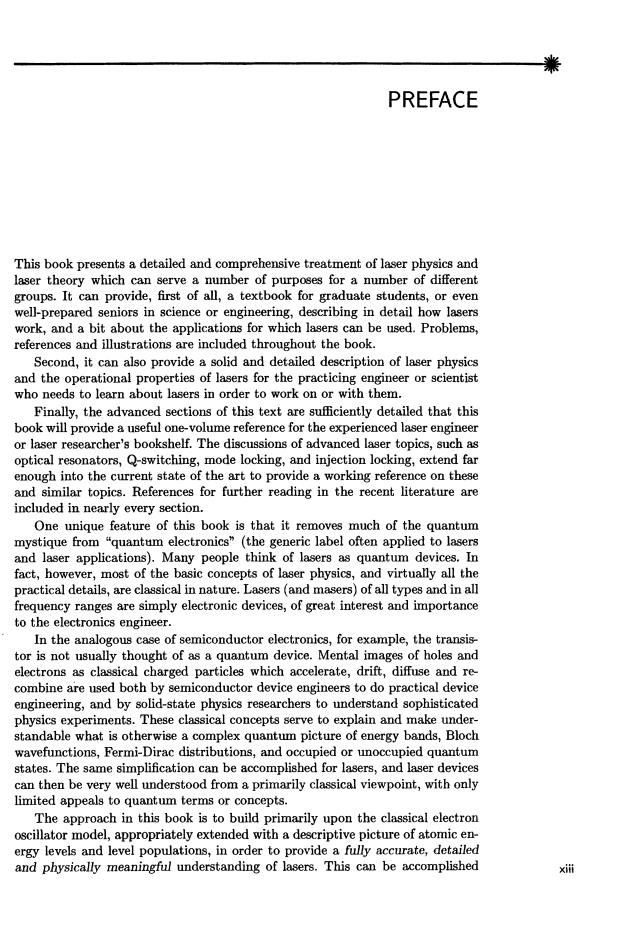
PREFACE This book presents a detailed and comprehensive treatment of laser physics and laser theory which can serve a number of purposes for a number of different groups.It can provide,first of all,a textbook for graduate students,or even well-prepared seniors in science or engineering,describing in detail how lasers work,and a bit about the applications for which lasers can be used.Problems, references and illustrations are included throughout the book. Second,it can also provide a solid and detailed description of laser physics and the operational properties of lasers for the practicing engineer or scientist who needs to learn about lasers in order to work on or with them. Finally,the advanced sections of this text are sufficiently detailed that this book will provide a useful one-volume reference for the experienced laser engineer or laser researcher's bookshelf.The discussions of advanced laser topics,such as optical resonators,Q-switching,mode locking,and injection locking,extend far enough into the current state of the art to provide a working reference on these and similar topics.References for further reading in the recent literature are included in nearly every section. One unique feature of this book is that it removes much of the quantum mystique from "quantum electronics"(the generic label often applied to lasers and laser applications).Many people think of lasers as quantum devices.In fact,however,most of the basic concepts of laser physics,and virtually all the practical details,are classical in nature.Lasers(and masers)of all types and in all frequency ranges are simply electronic devices,of great interest and importance to the electronics engineer. In the analogous case of semiconductor electronics,for example,the transis- tor is not usually thought of as a quantum device.Mental images of holes and electrons as classical charged particles which accelerate,drift,diffuse and re- combine are used both by semiconductor device engineers to do practical device engineering,and by solid-state physics researchers to understand sophisticated physics experiments.These classical concepts serve to explain and make under- standable what is otherwise a complex quantum picture of energy bands,Bloch wavefunctions,Fermi-Dirac distributions,and occupied or unoccupied quantum states.The same simplification can be accomplished for lasers,and laser devices can then be very well understood from a primarily classical viewpoint,with only limited appeals to quantum terms or concepts. The approach in this book is to build primarily upon the classical electron oscillator model,appropriately extended with a descriptive picture of atomic en- ergy levels and level populations,in order to provide a fully accurate,detailed and physically meaningful understanding of lasers.This can be accomplished xi带
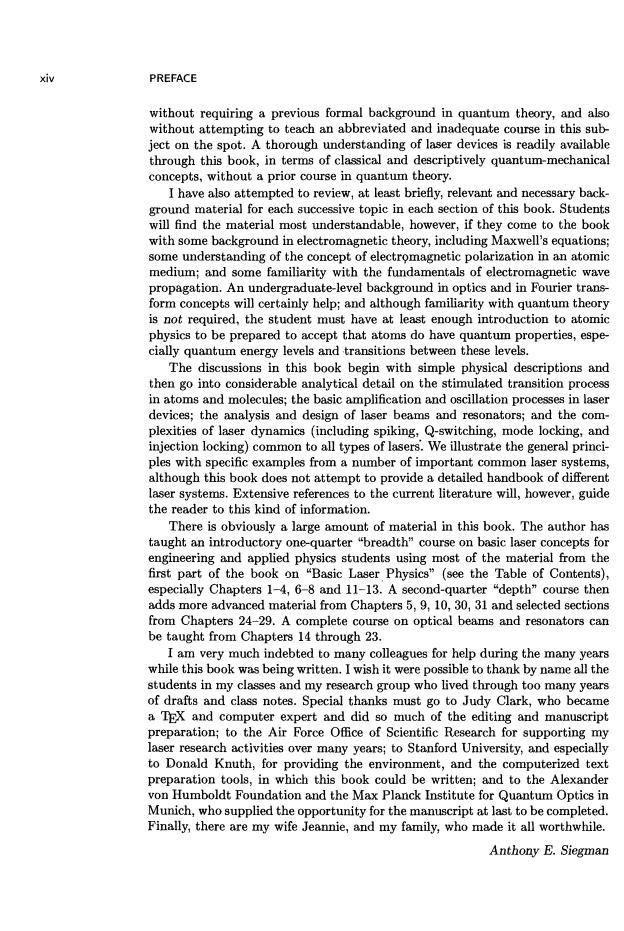
xiv PREFACE without requiring a previous formal background in quantum theory,and also without attempting to teach an abbreviated and inadequate course in this sub ject on the spot.A thorough understanding of laser devices is readily available through this book,in terms of classical and descriptively quantum-mechanical concepts,without a prior course in quantum theory. I have also attempted to review,at least briefly,relevant and necessary back- ground material for each successive topic in each section of this book.Students will find the material most understandable,however,if they come to the book with some background in electromagnetic theory,including Maxwell's equations; some understanding of the concept of electromagnetic polarization in an atomic medium;and some familiarity with the fundamentals of electromagnetic wave propagation.An undergraduate-level background in optics and in Fourier trans- form concepts will certainly help;and although familiarity with quantum theory is not required,the student must have at least enough introduction to atomic physics to be prepared to accept that atoms do have quantum properties,espe- cially quantum energy levels and transitions between these levels. The discussions in this book begin with simple physical descriptions and then go into considerable analytical detail on the stimulated transition process in atoms and molecules;the basic amplification and oscillation processes in laser devices;the analysis and design of laser beams and resonators;and the com- plexities of laser dynamics (including spiking,Q-switching,mode locking,and injection locking)common to all types of lasers.We illustrate the general princi- ples with specific examples from a number of important common laser systems, although this book does not attempt to provide a detailed handbook of different laser systems.Extensive references to the current literature will,however,guide the reader to this kind of information. There is obviously a large amount of material in this book.The author has taught an introductory one-quarter "breadth"course on basic laser concepts for engineering and applied physics students using most of the material from the first part of the book on "Basic Laser Physics"(see the Table of Contents), especially Chapters 1-4,6-8 and 11-13.A second-quarter "depth"course then adds more advanced material from Chapters 5,9,10,30,31 and selected sections from Chapters 24-29.A complete course on optical beams and resonators can be taught from Chapters 14 through 23. I am very much indebted to many colleagues for help during the many years while this book was being written.I wish it were possible to thank by name all the students in my classes and my research group who lived through too many years of drafts and class notes.Special thanks must go to Judy Clark,who became a TEX and computer expert and did so much of the editing and manuscript preparation;to the Air Force Office of Scientific Research for supporting my laser research activities over many years;to Stanford University,and especially to Donald Knuth,for providing the environment,and the computerized text preparation tools,in which this book could be written;and to the Alexander von Humboldt Foundation and the Max Planck Institute for Quantum Optics in Munich,who supplied the opportunity for the manuscript at last to be completed. Finally,there are my wife Jeannie,and my family,who made it all worthwhile. Anthony E.Siegman